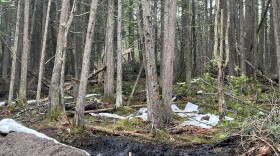A species that was wiped out in the Lower Peninsula more than a century ago is coming back — at least that’s what scientists are hoping.
Three tribes will introduce the Arctic grayling to the Boardman, Manistee and Maple rivers in northern Michigan later this year.
“This effort is focused on bringing back this iconic native fish to several northern Michigan trout streams. It’s an experiment,” said Dan Mays, a biologist with the Grand Traverse Band of Ottawa and Chippewa Indians.
The Grand Traverse Band, the Little River Band of Ottawa Indians and the Little Traverse Bay Bands of Odawa Indians will receive eggs this May.
The fish that hatch from those eggs will be raised in various setups along the three rivers until they’re released.
“We're going to be imprinting these fish, raising them in the waters where they're going to be released, so they get acclimated to the water conditions,” Mays said. “They hone in on the chemical cues in the water, so hopefully they return to those same sites to reproduce.”
Arctic grayling were abundant in streams across Michigan before logging and overfishing wiped them out. Mays said they were last seen in the Lower Peninsula around 1905 and in the Upper Peninsula around 1936.
“This is one of those fish … that were here when the tribe’s ancestors were here," he said. "[They were] interacting with those fish, and it's important to reconnect that interaction with the people, and the fish, and the environment."
Years of research and preparation from the tribes, the Michigan Department of Natural Resources, Trout Unlimited, several universities and other entities have made it possible to reach this point, he said.
The state has tried to stock and reintroduce Arctic grayling a number of times without success. But streamside rearing helped reintroduce Arctic grayling in Montana, and Mays hopes that approach works for Michigan.
“I think with the research and efforts that have been put into it this time, we have a much higher chance of success,” he said. “We are really looking closely at exactly where these fish are going to go, which streams have the highest likelihood of success. And we're going to be doing detailed monitoring and analysis to learn how are these fish interacting, how are they behaving, where are they moving, what is the survival rate.”
The three tribes will receive the eggs, originally gathered in Alaska, in the spring with plans to raise and release the fish throughout the summer and early fall.






